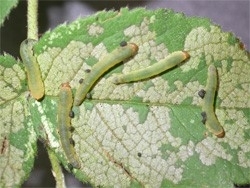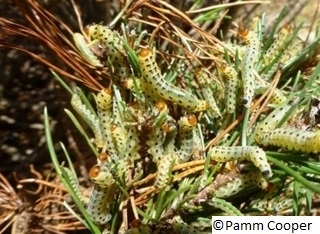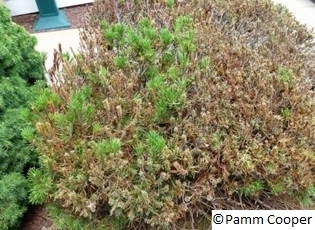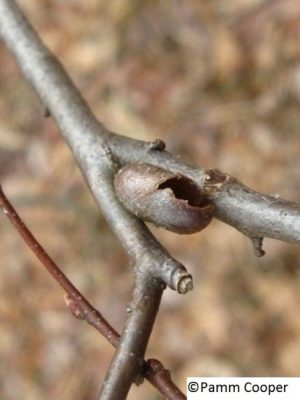Sawflies are members of the insect order Hymenoptera that includes ants, wasps, and bees. Sawfly adults are wasp-like and have a saw-like tube which is used to incise holes in plant tissue for depositing eggs. Unfortunately for gardeners, sawflies often lay large numbers of eggs on a single plant, and the larvae can devour large amounts of plant material in short order. Sawflies are usually plant specific, so pine sawflies may have many pines as a host plant, and rose sawflies will attack many kinds of roses, but neither will find hibiscus suitable for food. Each species of sawfly feeds on a specific host.
There are several sawfly species that are serious pests in the landscape. Be vigilant and try to detect them as soon as possible. If there are hibiscus, dogwoods, mugo pine, or roses in the garden or landscape, scouting the undersides of leaves or along needles of susceptible plants is a practical way to detect these pests early.
Rose Sawfly

In the spring the rose sawfly can be a problem on many roses, including the insect-resistant Knock-Out™ varieties. The initial feeding damage from the smallest larval instar is sometimes mistaken for disease, as leaves turn brown over time and then curl up. The larva chew the leaves on one surface, so the other side can look good until the damage is severe enough to cause browning of leaf tissue. Most damage will end by late-June or early-July as larvae pupate. Larvae may be sprayed directly with insecticidal soap, if needed. Take care not to use any insect control products that are injurious to bees when plants are flowering. Next year, look at the leaf undersides periodically to detect larvae as soon as possible.
Hibiscus Sawfly

Hibiscus sawfly larvae feed on members of the Mallow Family. Larvae are green and have dark heads, and begin feeding on the undersides of leaves, moving to the upper sides as they become larger. To catch quickly, check the undersides of leaves. They will consume every part of the leaf except the veins, and the damage may be confused with that of scarab beetles. Manage these pests by handpicking larvae, or removing leaves having many of them. Cocoons are found on the base of the plants and can be removed and disposed. Insecticidal soaps or spinosad are effective means of control also.
Pine Sawflies
There are two species of sawfly that are serious pests of pines in New England, the redheaded pine sawfly and the European pine sawfly. The European pine sawfly commonly attacks Mugo pines in the landscape, but will also feed on Japanese, Scotch, and other pines. Usually, pine sawfly larvae are found on young trees that are between 1-14 feet tall. Damage first appears as browning of the needles and gradually the branches will become stripped of needles. This is the result of the larval habit of feeding together in large groups. If all the needles have been consumed from one tree, the sawfly larvae will move to another nearby pine. Best control is when larvae are small to keep damage minimal.
Eggs can be removed if found on needles over the winter. Destroy the material, do not simply discard on the ground. Also, clip off branches that have multitudes of larvae, or try to knock them off into a bucket of soapy water. Summer oils and insecticidal soap can be applied to larvae feeding on ornamental pines. Make sure coverage includes all the larvae.

White pine sawflies, Neodiprion pinetum on a mugo pine.

Mugo pine damaged by the same sawflies, July 8, 2013. Photos ©2013 Pamm Cooper
Dogwood Sawflies
A pest of the Cornus species, the Macremphytus tarsatus sawfly larvae can cause severe damage to the foliage of dogwoods, but seldom cause the death of the plants because defoliation occurs late in the season. Feeding takes place throughout the summer, with larval groups feeding on the undersides of leaves. Larvae have two distinct looks: one is powdery white and the other is green, black, and yellow. They rest in a curled-up position on the undersides of leaves.

Michael Masiuk photo

Michigan State University photo
When they are done feeding, dogwood sawfly larvae wander off to find a suitable place to pupate, preferring rotting wood. They have been known to bore into any wooden structure, including homes.
Sawfly Control

Sawfly adults are hard to spot as they appear to be wasps hanging about the garden. Acquaint yourself with the life cycles of the sawflies that are pests in your gardens or landscapes, and check for larva before you see damage. The smaller you find them, the easier it is to get rid of them. To control sawfly larvae, try to choose the method or product least harmful to other insects. Products labeled for sawfly control can be used effectively when they make direct contact with the insect or are applied to foliage that will be ingested. Check label for method of application. Or look for pupal cases on or near the plant and destroy them. Sawfly larvae are easily knocked off plants, and can be dropped into soapy water to finish them off. If problems occur year after year, scout early for eggs or larva. Check undersides of leaves, and look for small holes indicative of sawfly feeding.
There are many other sawfly larvae that affect home garden plants and trees and sometimes homeowners may confuse these with caterpillars. If applications of the natural insecticide Bacillus thuringiensis (Bt) are used, they will not be effective on sawflies, but new strains of this bacteria are being produced that may in time prove effective against these pests.
Despite good cultural practices, pests and diseases at times may appear. Chemical control should be used only after all other methods have failed.
For pesticide information or other questions please call toll free: 877-486-6271.
Written by Pamm Cooper UConn Home & Garden Education Center July, 2013
Revised by UConn Home and Garden Education Center 2016